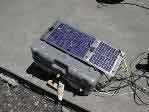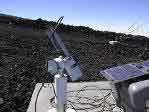More than two years after road access and electrical power to the Mauna Loa Observatory was cut off by lava flows, NOAA staff continue to make critical measurements of the atmosphere and other environmental variables at the remote site.
In 2023, observatory staff installed solar panels at the site and resumed some measurements, including the independent carbon dioxide monitoring programs run by the Global Monitoring Laboratory and Scripps Institution of Oceanography, as well as other atmospheric measurements.
Construction of a temporary road to access the observatory site is anticipated to begin in summer 2025.
Media can contact: Theo Stein (303) 819-7409 (theo.stein@noaa.gov)
Organization(s):
 National Aeronautics and Space Administration (NASA), Goddard
Space Flight Center
National Aeronautics and Space Administration (NASA), Goddard
Space Flight Center
What does this program measure?
Aerosol Optical Depth (AOD) – No units
How does this program work?
A sunphotometer is used to measure the extinction of direct beam spectral solar radiation. Robots approximately 18" high with a 1-foot diameter base are used in conjunction with a data logger, data transmission device, batteries, solar panels, and antenna for data transmission. The system runs continuously and automatically at MLO.
Why is this research important?
AERONET can provide continuous measurements of aerosol optical depth (AOD), an important climate forcing agent. AOD is needed in satellite validation and atmospheric correction, and MLO is used to calibrate the instruments since the low and stable AOD are ideal for this purpose. AERONET can provide long term comparisons between the in situ CMDL measurements of size distribution at Bondville, IL and the retrievals measured from the CIMEL automatic sunphotometers. The MLO instrument will periodically be swapped with a field instrument to provide a well calibration instrument for field intercomparisons. Long term particle size distribution comparisons will provide validation of the radiometric inversion scheme.
Are there any trends in the data?
The trends are seasonal at MLO, with a maximum in spring (March-May) resulting from aerosols transported from Asia. No inter-annual long term trends have been detected at MLO.
How does this program fit into the big picture?
What is it's role in global climate change?
AERONET is a global network of sun/sky radiometers that is monitoring AOD and aerosol optical properties for AOD trend analysis, optical properties characterization, and for validation of satellite retrievals. Aerosol radiative forcings are one of the largest uncertainties in climate change studies.
Comments and References
Calibration of AERONET sun/sky radiometers at MLO is critical in maintaining a high level of accuracy and consistency to the network database.
Lead Investigator(s):
Brent Holben
(alternate email)
301-614-6658
Tom Eck
301-614-6625
MLO Contact(s):
Paul Fukumura
808-933-6965 (x223)
Steve Ryan
808-933-6965 (x235)
Web Site(s)
Date Started
April, 1996
Related Programs
Trinidad Head Lidar
Air Quality Control
Solar Radiation


